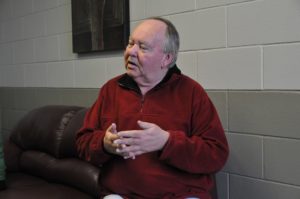Mocc Walk effective in the battle against diabetes

By Colin Graf
THUNDER BAY—Over 800 First Nation peoples across Ontario are walking the road to better health thanks to Bob Fenton and the Ontario Native Women’s Association.
The group’s annual “Mocc Walk”, designed to promote daily walking, has convinced 882 registrants to get up and get moving throughout May and June, says Bob Fenton, diabetes education coordinator with the Association.
The Mocc Walk asks people to record the distance they walk across the 2 months, and awards them a point for every 10 minutes of walking. It’s designed to help fight the epidemic of diabetes among Indigenous people, Fenton notes.
Since the program began in 2003, Fenton has been collecting stories of how the walk has helped improve people’s health.
“I have some wonderful stories,” shares Fenton. “I would really like to put them in a book one day.”
He remembers the story of two sisters, one of whom was so obese she would not leave her house. Her sister begged her to join the Mocc Walk, and eventually she agreed. At first, the one sister walked only from her door to the end of the driveway and back, but by the end of June she was out meeting friends, going to the mall, and was losing weight.
One single mother with 3 young kids explained to Fenton how she used the walk to teach her children about the medicines in trees and flowers, and to work on mental math problems.
“Without the walk, she said she would never have had that opportunity,” Fenton recalls.
One group of four walkers monitored their blood glucose and blood pressure during the walk. According to Fenton, by the end they had collectively lost 45 pounds, and all of their blood levels were in the normal range, according to Fenton.
“Even helping people lose that first five pounds can be key to better health,” says Fenton.
This year was not a record year for the Mocc Walk, as the highest number of walkers ever was around 1400. Fenton believes that the rainy weather in June, combined with a rash of suicides in northern communities, may have put a damper on participation.
While participants come from across the province, it is especially popular in the north, where diabetes is an acute concern, and the Mocc Walk certificates are often a source of pride, according to Fenton.
“If I spell a name wrong on those, I can be in trouble,” he says with a chuckle.
Still, Fenton knows diabetes is no laughing matter. Rates of the illness are not going down among Indigenous demographics, and Fenton says he was told at a recent conference that 1 out of every 4 Indigenous people in Canada is affected.
Many people aren’t aware just how much physical activity can help with managing the disease, he says, making the Mocc Walk an effective weapon in the battle against diabetes.
Taking part in the Mocc Walk has become a hit in far-flung areas. While it remains popular in the north, Fenton also has over 110 walkers from Akwesasne, near Montreal, at the opposite side of the province. While most participants are women, the number of men is growing, Fenton notes.
While the participants are separated by huge distances, Fenton tries to bring them together by contacting each one personally, either by phone or e-mail, dispensing encouragement and collecting a lot of personal stories along the way.
At one time, diabetes was unknown in First Nation, Metis and Inuit communities, according to the Ontario Native Women’s Association website. The group says Indigenous people are 3 to 4 times more likely to experience Type 2 Diabetes than non-Indigenous Canadians. While Type 2 diabetes used to be a disease of older people, the illness is turning up more and more in Indigenous youth today, the site states. Acquiring the condition at a young age makes it more likely that those afflicted will have complications, and at a younger age than in the past.
Although it is increasingly common in Indigenous people, diabetes can be prevented and/or managed by “walking” a balanced life; eating a healthy diet; living an active lifestyle; and having a positive attitude, according to the ONWA.


